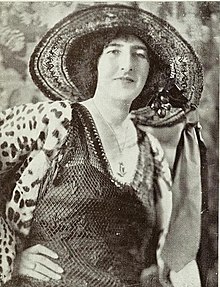|
Nell St. John Montague
Nell St. John Montague (27 June 1875 – 23 August 1944) was the pen name of a British actress, writer, socialite and "clairvoyante", born Eleanor Lucie-Smith in India. Early lifeEleanor Lilian Helene Lucie-Smith was born in Jabalpur, India, to an English father and a Scottish mother. Her father, Major-General Charles Bean Lucie-Smith, was stationed there with the British Army.[1] CareerMontague wrote The Irish Lead (1916), a play she also directed and acted in, to raise funds for Irish prisoners-of-war.[2] She also starred in An Interrupted Divorce in London, and her own short play, The Barrier. In 1922 she wrote and appeared in a one-act farce, Room 7, on the London stage.[3] She appeared in two silent films, The Glorious Adventure (1922)[4] and A Gipsy Cavalier (1923).[5] She wrote the anti-vivisection short story "The Hallmark of Cain", which was adapted into the short film All Living Things (1939).[6] The film was remade in 1955.[7] Montague called herself a "clairvoyante", and her fortune telling was popular in society circles.[8][9][10] She appeared on very early British television, in 1932, reading palms, and "her performance evoked a volume of mail at Portland Place that would have been gratifying to the producer of a popular revue", according to one report.[11] She was invited to the wedding of Princess Marina of Greece and Denmark in 1934, and brought a crystal ball as a gift.[12] She also tried to use her visions to solve crimes.[13] She kept a pet monkey, and posed with the monkey for portraits, saying it brought good luck.[8] She wrote about her abilities and her predictions in her memoir, Revelations of a Society Clairvoyante (1926),[1] and in The Red Fortune Book (1924). She also wrote a novel, The Poison Trail (1930).[14] Personal lifeMontague married Irish landowner and judge Henry Standish-Barry (1873-1945) in 1899.[15] They had three children, Charles (1900-1918), Marcella (Mercy), and Margaret. Her son died in World War I. She died in 1944, in London, aged 69 years, in a bombing during World War II. It was widely publicized that she predicted the violent circumstances of her death, when she said "I saw a fiery streak. Then a red mist spread over everything."[13] Her gravesite is in Bishopstone, East Sussex. Her name appears on a memorial plaque commemorating the war dead in Bishopstone.[2] References
External links
|
